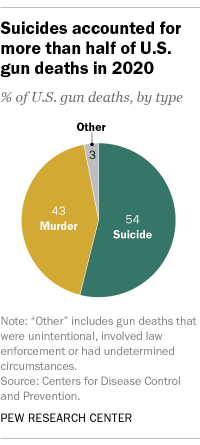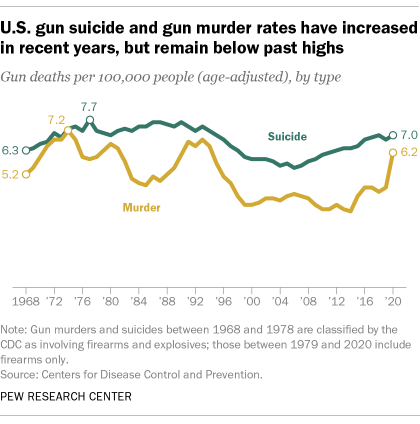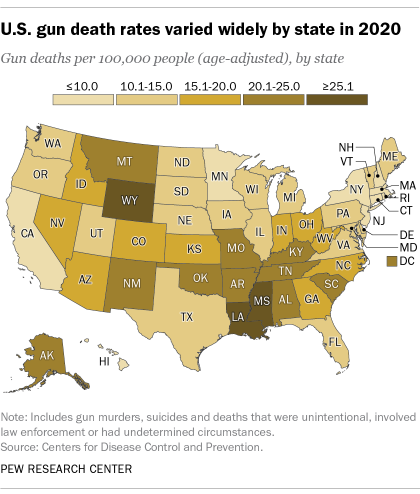safety-lane.com 07105
chiropractic-lane.com
www.cbd-lane.com
NEWARK
http://www.healthy-lane.com/
What the data says about gun deaths in the U.S.
More Americans died of gun-related injuries in 2020 than in any other year on record, according to recently published statistics from the Centers for Disease Control and Prevention (CDC). That included a record number of gun murders, as well as a near-record number of gun suicides. Despite the increase in such fatalities, the rate of gun deaths – a statistic that accounts for the nation’s growing population – remains below the levels of earlier years.
Here’s a closer look at gun deaths in the United States, based on a Pew Research Center analysis of data from the CDC, the FBI and other sources. You can also read key public opinion findings about U.S. gun violence and gun policy in our recent roundup.
How many people die from gun-related injuries in the U.S. each year?

In 2020, the most recent year for which complete data is available, 45,222 people died from gun-related injuries in the U.S., according to the CDC. That figure includes gun murders and gun suicides, along with three other, less common types of gun-related deaths tracked by the CDC: those that were unintentional, those that involved law enforcement and those whose circumstances could not be determined. The total excludes deaths in which gunshot injuries played a contributing, but not principal, role. (CDC fatality statistics are based on information contained in official death certificates, which identify a single cause of death.)
What share of U.S. gun deaths are murders and what share are suicides?
Though they tend to get less public attention than gun-related murders, suicides have long accounted for the majority of U.S. gun deaths. In 2020, 54% of all gun-related deaths in the U.S. were suicides (24,292), while 43% were murders (19,384), according to the CDC. The remaining gun deaths that year were unintentional (535), involved law enforcement (611) or had undetermined circumstances (400).
What share of all murders and suicides in the U.S. involve a gun?
Nearly eight-in-ten (79%) U.S. murders in 2020 – 19,384 out of 24,576 – involved a firearm. That marked the highest percentage since at least 1968, the earliest year for which the CDC has online records. A little over half (53%) of all suicides in 2020 – 24,292 out of 45,979 – involved a gun, a percentage that has generally remained stable in recent years.
How has the number of U.S. gun deaths changed over time?
The 45,222 total gun deaths in 2020 were by far the most on record, representing a 14% increase from the year before, a 25% increase from five years earlier and a 43% increase from a decade prior.
Gun murders, in particular, have climbed sharply in recent years. The 19,384 gun murders that took place in 2020 were the most since at least 1968, exceeding the previous peak of 18,253 recorded by the CDC in 1993. The 2020 total represented a 34% increase from the year before, a 49% increase over five years and a 75% increase over 10 years.
The number of gun suicides has also risen in recent years – climbing 10% over five years and 25% over 10 years – and is near its highest point on record. The 24,292 gun suicides that took place in 2020 were the most in any year except 2018, when there were 24,432.
How has the rate of U.S. gun deaths changed over time?
While 2020 saw the highest total number of gun deaths in the U.S., this statistic does not take into account the nation’s growing population. On a per capita basis, there were 13.6 gun deaths per 100,000 people in 2020 – the highest rate since the mid-1990s, but still well below the peak of 16.3 gun deaths per 100,000 people in 1974.

The gun murder and gun suicide rates in the U.S. both remain below their peak levels. There were 6.2 gun murders per 100,000 people in 2020, below the rate of 7.2 recorded in 1974. And there were 7.0 gun suicides per 100,000 people in 2020, below the rate of 7.7 measured in 1977. (One caveat when considering the 1970s figures: In the CDC’s database, gun murders and gun suicides between 1968 and 1978 are classified as those caused by firearms and explosives. In subsequent years, they are classified as deaths involving firearms only.)
Which states have the highest and lowest gun death rates in the U.S.?

The rate of gun fatalities varies widely from state to state. In 2020, the states with the highest rates of gun-related deaths – counting murders, suicides and all other categories tracked by the CDC – included Mississippi (28.6 per 100,000 people), Louisiana (26.3), Wyoming (25.9), Missouri (23.9) and Alabama (23.6). The states with the lowest rates included New York (5.3), Rhode Island (5.1), New Jersey (5.0), Massachusetts (3.7) and Hawaii (3.4).
How does the gun death rate in the U.S. compare with other countries?
The gun death rate in the U.S. is much higher than in most other nations, particularly developed nations. But it is still far below the rates in several Latin American countries, according to a 2018 study of 195 countries and territories by researchers at the Institute for Health Metrics and Evaluation at the University of Washington.
The U.S. gun death rate was 10.6 per 100,000 people in 2016, the most recent year in the study, which used a somewhat different methodology from the CDC. That was far higher than in countries such as Canada (2.1 per 100,000) and Australia (1.0), as well as European nations such as France (2.7), Germany (0.9) and Spain (0.6). But the rate in the U.S. was much lower than in El Salvador (39.2 per 100,000 people), Venezuela (38.7), Guatemala (32.3), Colombia (25.9) and Honduras (22.5), the study found. Overall, the U.S. ranked 20th in its gun fatality rate that year.
How many people are killed in mass shootings in the U.S. every year?
This is a difficult question to answer because there is no single, agreed-upon definition of the term “mass shooting.” Definitions can vary depending on factors including the number of victims and the circumstances of the shooting.
The FBI collects data on “active shooter incidents,” which it defines as “one or more individuals actively engaged in killing or attempting to kill people in a populated area.” Using the FBI’s definition, 38 people – excluding the shooters – died in such incidents in 2020.
The Gun Violence Archive, an online database of gun violence incidents in the U.S., defines mass shootings as incidents in which four or more people are shot, even if no one was killed (again excluding the shooters). Using this definition, 513 people died in these incidents in 2020.
Regardless of the definition being used, fatalities in mass shooting incidents in the U.S. account for a small fraction of all gun murders that occur nationwide each year.
How has the number of mass shootings in the U.S. changed over time?

The same definitional issue that makes it challenging to arrive at an exact number of mass shooting fatalities comes into play when trying to determine the frequency of U.S. mass shootings over time. The unpredictability of these incidents also complicates matters: As Rand Corp. noted in a research brief, “Chance variability in the annual number of mass shooting incidents makes it challenging to discern a clear trend, and trend estimates will be sensitive to outliers and to the time frame chosen for analysis.”
The FBI found an increase in active shooter incidents between 2000 and 2020. There were three such incidents in 2000; by 2020, that figure had increased to 40.
Which types of firearms are most commonly used in gun murders in the U.S.?
In 2020, handguns were involved in 59% of the 13,620 U.S. gun murders and non-negligent manslaughters for which data is available, according to the FBI. Rifles – the category that includes guns sometimes referred to as “assault weapons” – were involved in 3% of firearm murders. Shotguns were involved in 1%. The remainder of gun homicides and non-negligent manslaughters (36%) involved other kinds of firearms or those classified as “type not stated.”
It’s important to note that the FBI’s statistics do not capture the details on all gun murders in the U.S. each year. The FBI’s data is based on information voluntarily submitted by police departments around the country, and not all agencies participate or provide complete information each year.
Note: This is an update of a post originally published on Aug. 16, 2019.
via Blogger https://bit.ly/3MTiVJ5

Recent Comments